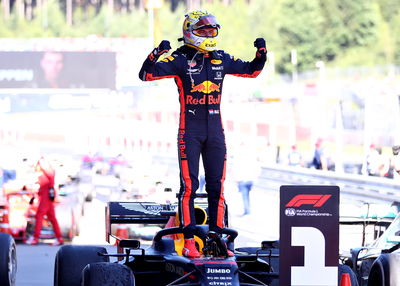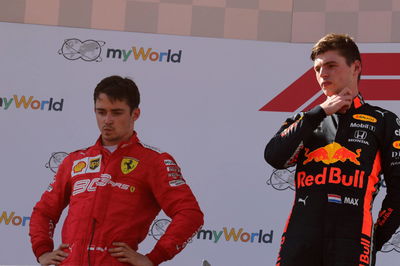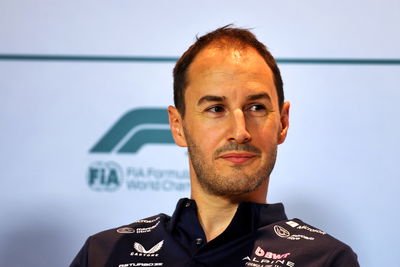F1 Race Analysis: How Max Verstappen took his greatest win yet
Max Verstappen’s fan club has become an ever-present force at grands prix all across Europe in recent years, with Austria perhaps being the race they are most visible, turning the bowl cut out in the middle of the Styrian forests bright orange.
But just seconds into Sunday’s race at the Red Bull Ring, it looked like the congregation would be leaving Spielberg disappointed. A front row start was frittered away as Verstappen bogged down due to anti-stall kicking, causing six cars to stream past on the run to Turn 1.
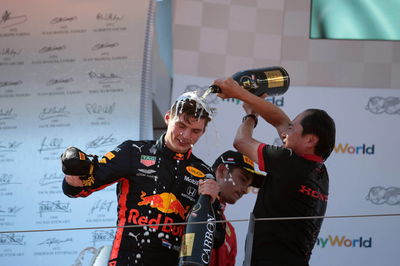
Max Verstappen’s fan club has become an ever-present force at grands prix all across Europe in recent years, with Austria perhaps being the race they are most visible, turning the bowl cut out in the middle of the Styrian forests bright orange.
But just seconds into Sunday’s race at the Red Bull Ring, it looked like the congregation would be leaving Spielberg disappointed. A front row start was frittered away as Verstappen bogged down due to anti-stall kicking, causing six cars to stream past on the run to Turn 1.
Max had other ideas, though, with his charge through the field to take the greatest victory of his F1 career to date proving just what a phenomenal talent the 21-year-old is.
It was a victory made all the more impressive by the fact we did not get a true read on Red Bull’s long run pace on Friday because – of all people – Verstappen binned his car during the qualifying simulations, ending his day early. On a track rewarding straight-line speed on the three long straights, it seemed unlikely Red Bull would be a factor in the fight for victory.
That was even before Verstappen’s sluggish start, which left him languishing behind Red Bull teammate Pierre Gasly through the first lap and had given pole-sitter Charles Leclerc an easy run up the hill to Turn 3. It looked like game over.
Verstappen offered a taste of things to come by pulling a stunning overtake on Gasly around the outside of the high-speed Turn 9 (missed by the TV cameras) to take seventh. Ferrari driver Sebastian Vettel – himself recovering from P9 on the grid – was forging a path for Verstappen to follow through ahead, picking off Lando Norris and Kimi Raikkonen following their impressive starts.
But by the time Verstappen had got up to P5 on Lap 9, he was already 15 seconds off race leader Leclerc. Surely the race was already lost?
Verstappen quickly proved the Red Bull RB15 was on-pace with the leading cars in Austria. Even as Leclerc began to put the hammer down at the front in a bid to try and gap the Mercedes drivers, Verstappen kept the gap stable. From Lap 9 until Leclerc pitted on Lap 22, the gap had been slightly reduced to 13.5 seconds, despite a flat-spot on his set of Medium tyres sustained on the opening lap that the Dutchman claimed “limited” his pace.
So “limited” was Verstappen that he was able to put in a series of fast laps while extending his stint. From the time Leclerc pitted, he stayed consistently in the low 1m09s range, peaking with a pair of 1m09.1s times before he eventually came in at the end of Lap 31.
Verstappen came back out on-track in fourth place, gaining a position after Lewis Hamilton was forced into a front wing change that cost him time. Verstappen’s pace had been more or less matched by Leclerc despite the Ferrari driver’s fresher tyres, meaning the 13-second gap remained once he was back out on-track.
With nine-lap fresher tyres, Verstappen hit the ground running. He was straight into the 1m08s range, and while Leclerc was able to match his pace to begin with, he soon began to lose a few tenths each lap as his tyres wore. The same was true for Valtteri Bottas and Vettel running in P2 and P3, allowing Verstappen to close up. They had both pitted one lap earlier than Leclerc for their set of Hards.
Vettel made a good effort of keeping Verstappen back, opting to hang wide at Turn 3 to try and compromise the Red Bull’s exit, only to run too deep on Lap 50 and allow Verstappen to sail past on the run to Turn 4. Vettel hadn’t done much to stunt Verstappen’s charge, with Leclerc’s struggles ahead resulting in the gap to fall to less than seven seconds.
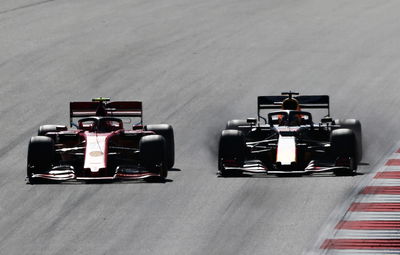
Verstappen continued to turn the screw as he reeled in Bottas, making light work of the Mercedes driver with a dive up the inside at Turn 4 to get past at the first attempt.
It was at this point Verstappen first thought he could win. “Once I got past Valtteri, I knew that with the pace that we had I could definitely have a go at it,” he said. “But you never know, you just keep pushing.”
And so he kept pushing, with five seconds to make up. As Leclerc struggled with lapped cars, Verstappen was able to dart between them, causing the gap to drop by as much as nine-tenths of a second per lap. Leclerc was informed Verstappen was catching, but told his engineer to leave him alone, wishing to focus on getting his head down.
It was a fight he was always destined to lose. It may have taken Verstappen three attempts and a slight nudge on exit at Turn 3 to finally get the move to stick, but even Leclerc himself admitted after the race that he was never likely to stay ahead such was the Red Bull’s advantage.
The move itself? It was hard, yes, but deemed fair by the stewards. A comparison was made in their decision to the incident between Lewis Hamilton and Nico Rosberg at the very same corner in 2016 – with there being a huge difference in the action of the driver on the inside. While Rosberg clearly looked at Hamilton on the left before making the move, Verstappen always had his eyes on the apex; it was a late apex, yes, but it was still an apex.
And so came the finest win of Verstappen’s career to date. The other five were all impressive in their own ways, yes. But this was a stunning fight through the field as he put his peers to the sword.
Hopefully that will be the prevailing story from Sunday in Austria, amid all of the debate about stewarding calls and delays in decision-making. Because Verstappen's victory should not be played down.
